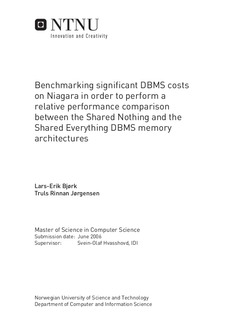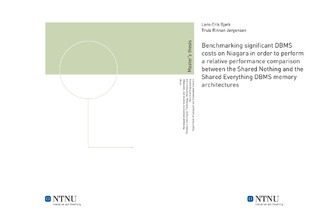| dc.description.abstract | This report carries out a relative performance comparison between two DBMS architectures on the Multi Core, Single Die (MCSD) realization Niagara. The two DBMS architectures in question are Shared Nothing (SN) and Shared Everything (SE). The MCSD field is rapidly evolving, and we expect that this technology will become increasingly important in the near future.
In order to carry out the comparison, the performance of the architectures must be calculated. This calculation depends on the cost figures associated with each architectural approach. To identify these costs, we present the design solutions made and results discovered in our previous work. Based on this, the most significant costs are determined and scheduled to be micro benchmarked.
The natural next step is to examine possible techniques to implement the benchmarks. In order to do this, we first expand on the Niagara chip and the platform on which the micro benchmarks will run. Having a sufficient theoretical platform to continue, we move on to describe the implementation of each micro benchmark in detail.
After benchmarking all the most significant costs, we thoroughly discuss the results, some of which are indeed surprising. The costs which are not benchmarked are based on assumptions from our previous work and recalculated to apply to Niagara.
For both SN and SE, we evaluate the system for two classes of transactions. The first class is transactions touching one tuple (called simple), the second is transactions touching four tuples (called complex). Each class has two instances, read and update. In order to perform the subsequent analysis, the decomposition of each transaction is presented in detail.
When analyzing the outcome of the calculations, interesting results emerge. First, we note that SE is the cheapest alternative when evaluating the simple transactions. This is because the SN approach includes an administrative overhead component that does not pay off when the transaction only touches one tuple. However, for complex transactions, the overhead component results in a parallel gain for SN which outperforms SE.
Based on the most dominant costs of both architectures, we perform a sensitivity analysis. For SN, the analysis is based on the cost for message passing. For SE, it is based on the cost for synchronization. The goal of this analysis is two folded. First, it is interesting to see how the results vary. For example, what the ratio between the cost for message passing and the cost for synchronization must be in order to make the two approaches perform equally well. Second, the analysis indicate how error-prone each architecture is to erroneous estimation.
The sensitivity analysis examine the performance of SN and SE when the ratio between the cost for message passing and the cost for synchronization is varied. This is done in both the read and the update cases. In addition to examining the simple and the complex transactions, we examine general transactions were the number of operations are not predetermined.
The analysis of the general read transaction suggests that when the number of operations increases, the message passing and synchronization costs wipe out the impact of the other costs. It also suggests that when the cost of message passing is greater than 4 times the cost of synchronization, SE performs better when increasing the number of read operations. Similarly, if message passing is cheaper than 4 times the cost of synchronizing, SN is preferable. When increasing the number of update operations, the ratio is 3.33.
After concluding the analysis, we suggest a hybrid architecture that might combine the advantages of SN and SE. At the cost of introducing both message passing and synchronization, the architecture introduce parallelism in SE.
Lastly, we identify suggestions for future work. Realized and applied to the DBMS model introduced in this report, we believe that several of these suggestions can shrink some of the costs presented. | |

